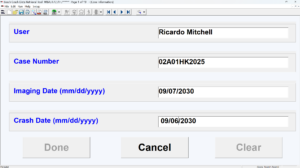

As an accident reconstruction expert, documenting the details of a crash investigation is crucial for an accurate analysis. The Event Data Recorder (EDR) report is an essential part of this process, providing critical data that can be used to reconstruct the event. To ensure a comprehensive and legally sound investigation, it’s important to include certain key details in the comment section of your EDR report. Here’s a guide on what to include:
1. Tire Size for All Wheels
Include the tire size for each wheel of the vehicle involved in the crash. This detail is vital because tire size can directly impact vehicle handling and braking performance. Knowing the exact tire sizes helps in understanding the vehicle’s pre-crash behavior and performance. For more insights into how vehicle specifications affect crash analysis, visit our Tire Analysis Services.
2. Vehicle Modifications
Take note of any modifications made to the vehicle. Whether it’s aftermarket parts, suspension changes, engine modifications, or alterations to the EDR system, these can significantly affect the vehicle’s performance during the crash and the accuracy of the EDR data. Explore our Vehicle Modifications Impact page for more.
3. Multiple VINs
If the vehicle has multiple Vehicle Identification Numbers (VINs), such as one on the vehicle and another on the frame, this must be commented on. It’s essential to document the reason for the multiple VINs, such as vehicle repairs, salvage, or rebuilds. This will ensure that any potential discrepancies are addressed in the investigation. Learn more about VIN analysis here.
4. Crash Scene Description
Provide a detailed description of the crash scene. This should include the location, environmental conditions (such as weather and road conditions), and any landmarks that may assist in contextualizing the crash. A clear description helps set the scene for the data you are analyzing. For detailed scene analysis, check out our Crash Scene Reconstruction Services.
5. Vehicle Information
In the report, make sure to specify the make, model, year, VIN, and color of the vehicle involved in the crash. Additionally, mention whether the vehicle is left-hand or right-hand driven. This is important for understanding the positioning of the vehicle and driver during the crash. For more on vehicle specifics, visit our Vehicle Information Services.
6. Damage Location of Vehicle
Document the specific areas of the vehicle that sustained damage. Whether it’s the front, rear, sides, or roof, the extent and location of the damage offer important insights into the nature of the crash and the forces involved. See our Crash Damage Analysis page for details.
7. Principal Direction of Force (PDOF)
It’s crucial to identify the Principal Direction of Force (PDOF), which is the direction in which the crash forces primarily acted. Understanding the PDOF can help establish the angle of impact and give clarity on how the vehicle was impacted during the crash.
8. Crush Depth
Comment on the crush depth at different points of the vehicle. This can help determine the severity of the crash and the level of energy absorbed by the vehicle’s structure. Crush depth can also provide insight into the effectiveness of the vehicle’s crumple zones. Learn more on crush depth analysis.
9. EDR Data Retrieval Details
Document how the EDR data was retrieved. Was it accessed via the OBD2 port or directly from the EDR module? Include the equipment used, along with any challenges or limitations you encountered during the process. This transparency ensures the data is reliable and properly sourced. Visit our EDR Data Retrieval Services for more information.
10. Pre-Crash Data
Comment on pre-crash data such as the vehicle’s speed, engine RPM, brake status, throttle position, and other relevant parameters. This information gives crucial insight into the vehicle’s actions just before the crash.
11. Impact and Post-Impact Data
Describe the impact severity, including whether safety systems like airbags and seatbelt pretensioners were deployed. Additionally, record the vehicle’s movements after the crash, as this data can offer valuable clues about the forces involved and the vehicle’s post-crash behavior.
12. Driver Behavior
If available, comment on the driver’s actions leading up to the crash. This could include speeding, erratic driving, or any other behavior that can be inferred from the data or from witness accounts. Explore more about driver behavior analysis.
13. Authority
Ensure you include the authority under which the data retrieval was conducted. Did you have written consent, oral permission, or a court order? Were any exceptions made? Documenting this ensures the data retrieval was performed legally and ethically, maintaining the integrity of the investigation.
14. Vehicle Configuration
Specify whether the vehicle is left-hand or right-hand driven. This information is particularly important if the crash occurred in a region where the side of the vehicle impacts might differ due to road conditions or driver positioning.
15. Investigator’s Conclusion
Finally, provide a clear and concise summary of your findings based on the EDR data and your crash investigation. Include any contributing factors you identified during the investigation, along with any relevant conclusions regarding the cause of the crash.
By thoroughly documenting these key details in the comment section of your EDR report, you ensure that your findings are comprehensive, legally sound, and valuable for both legal and investigative purposes. This thoroughness helps you present an objective and complete analysis that can make all the difference in reconstructing the events accurately.
For more information on accident reconstruction and EDR data retrieval services, visit our home page and explore our full range of services.

